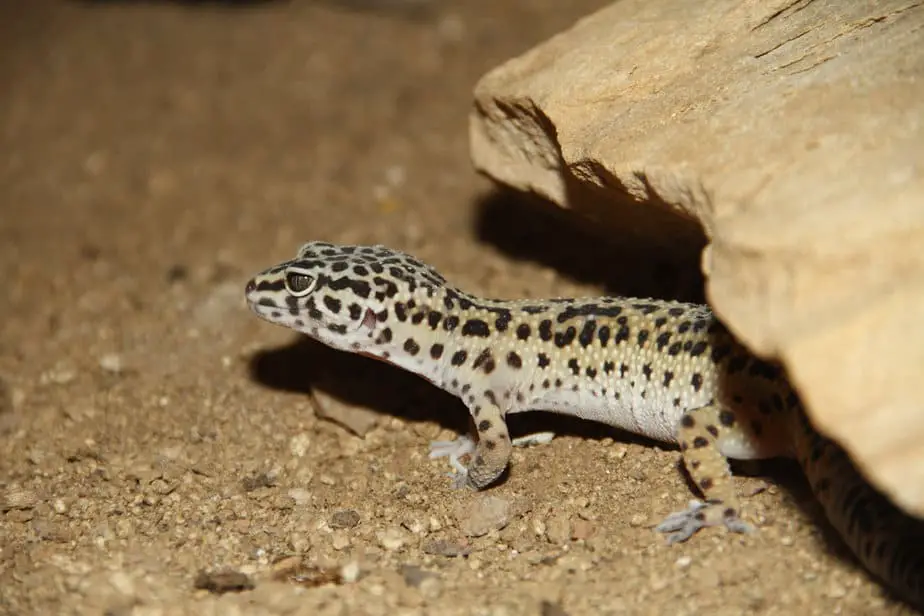
As a fellow leopard gecko enthusiast, I know that our little reptilian friends can sometimes leave us scratching our heads with their quirky behavior.
In this article, we’ll explore reasons our leopard geckos sleep outside their hide and what it might mean for their health and happiness.
By the end you should understand how to solve potential issues and help your leopard gecko get a good night’s rest.
Understanding Leopard Gecko Sleep Patterns
Normal Sleep Behavior
Leopard geckos are nocturnal animals, which means they are most active during the night and sleep throughout the day.
Typically, they like to find dark, small spaces to curl up and sleep, as these environments make them feel safe and secure.
When asleep, leopard geckos often curl themselves into a ball, wrapping their tail around their body. They may also lie on their side or stomach.
Environmental Factors
Several environmental factors can affect your leopard gecko’s sleep. One crucial factor is the lighting in their habitat.
Make sure there isn’t too much artificial lighting at night because this can confuse your gecko and make them think it’s daytime. This may cause them to sleep at night instead of during the day.
Loud noises can also disrupt your leopard gecko’s sleep. Reduce noise around their habitat, like televisions or radios. This creates a calm and quiet environment.
I know my Leo enjoys his peace and quiet!
Temperature and humidity also significantly affect your gecko’s sleeping habits.
Ensure the temperature within their habitat is appropriate, as temperature changes can cause stress and disrupt their sleep cycle.
Monitor humidity levels and make necessary adjustments to prevent your gecko from sleeping outside its hide due to discomfort.
Occasionally, leopard geckos may sleep out of their hide without reason.
In these cases, there might not be a specific cause for concern as long as the gecko’s overall behavior remains normal and no signs of illness are present.
Reasons for Sleeping Outside the Hide
Temperature and Humidity
Your leopard gecko might be sleeping outside the hide due to temperature or humidity issues in their enclosure. If a leopard gecko is too hot or cold, it can cause discomfort, leading them to seek a more comfortable spot.
Ensure the ground temperature is checked and should not exceed 93ºF. Improper humidity levels may lead to respiratory infections and shedding problems.
Your gecko may sleep outside its moist hide to avoid these issues.
Hide Size and Comfort
The size and comfort level of the hide might be causing your leopard gecko to sleep outside.
Geckos may sleep elsewhere if the hide is too small, cramped, or uncomfortable.
Assess the hide’s size and interior to ensure it meets your gecko’s needs, and consider providing multiple hides with varying sizes and materials.
Stress and Anxiety
Stress or anxiety in your leopard gecko may result in them sleeping outside the hide.
Sometimes geckos may not feel safe or secure inside the hide, affecting their sleeping patterns.
Observe your gecko’s behavior for any signs of stress or anxiety, adjust their environment to minimize disturbances, and ensure they feel secure.
Health Issues
Leopard geckos experiencing health issues might prefer sleeping outside their hide.
A gecko suffering from respiratory illness could have difficulty breathing and may choose to sleep outside the hide to access more oxygen.
\Keep an eye on your gecko’s overall health, and consult with a veterinarian if you suspect any health concerns are affecting their sleeping behavior.
How to Encourage Sleeping Inside the Hide
Getting your leopard gecko to sleep inside its hide can be challenging. With the right approach, you can create a comfortable and secure environment for your pet.
Here are some ways to encourage your gecko to sleep in the proper location:
Adjusting Habitat Conditions
Temperature and humidity play a crucial role in a leopard gecko’s well-being. Ensure that the cool side of the enclosure has a humidity level between 30% and 40% and a temperature between 75°F and 80°F.
The warm side should be between 88°F and 92°F. Keeping these temperatures and humidity levels in check can help make the hide more appealing to your gecko.
Offering Multiple Hide Options
Providing various hide options can help your gecko feel more secure in its environment.
Create a moist hide that allows your gecko to soften its skin during shedding, a warm hide for basking, and a cool hide for resting.
Placing these hides in the appropriate locations within the enclosure will encourage your gecko to use them.
Reducing Stress Factors
Stress can cause your gecko to avoid its hide. Make sure to minimize sudden changes in the environment, such as loud noises or frequent disruptions.
Ensure the enclosure is placed in a quiet area of your home, and limit handling your gecko during stressful times like shedding or when they are new to their environment.
Monitoring Health
If your leopard gecko consistently avoids its hide, it may indicate an underlying health issue.
Consult a veterinarian to rule out any health problems and to receive appropriate guidance on caring for your gecko.
Following these steps, you can create a comfortable environment for your leopard gecko and encourage it to sleep securely inside its hides.
